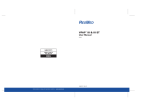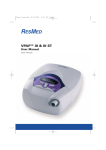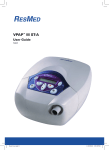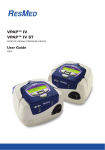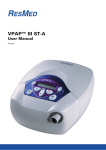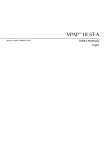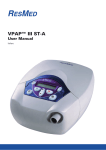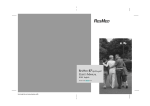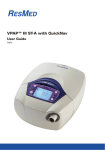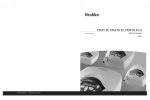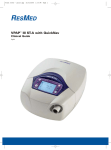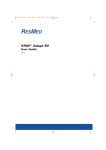Download ResMed VPAP III ST-A User's Manual
Transcript
Front Cover.qxd 9/11/2005 10:31 AM VPAP™ III ST-A User Manual English Page 1 Front Cover.qxd 9/11/2005 10:31 AM Page 2 248139/3 05 11 VPAP III ST-A USER ROW ENG Global leaders in sleep and respiratory medicine www.resmed.com 248139 illos.qxd 9/11/2005 10:33 AM Page 1 B D HUMIDIFIERS E SETTING UP THE VPAP III ST-A HUMIDAIRE 2i AND VPAP III ST-A VPAP™ III ST-A Illustrations A Component of 248139/3 1 SYSTEM COMPONENTS 1 HumidAire 2i™ 2 Docking station HumidAire 2iC™ Handle Water chamber © 2005 ResMed Ltd. LCD screen Control panel Removable front cover Air outlet 1 2 HumidAire™ 4 ResMed Passover Air filter cover Power switch Serial communications port (9-pin) Power sockets 2 Auxiliary port (15-pin) C © 2005 ResMed Ltd. 3 F HUMIDAIRE 2iC AND VPAP III ST-A OTHER ACCESSORIES 3 2m 2 52 cm 4 Water chamber © 2005 ResMed Ltd. 5 3m © 2005 ResMed Ltd. 4 1 © 2005 ResMed Ltd. 3 © 2005 ResMed Ltd. Docking station 248139 illos.qxd G 9/11/2005 10:33 AM Page 2 H USING A HUMIDAIRE HUMIDIFIER I USING A PASSOVER HUMIDIFIER REPLACING THE AIR FILTER (52 cm) (52 cm) 1 1 1 2 2 (2 m/3 m) (2 m/3 m) 2 4 4 © 2005 ResMed Ltd. © 2005 ResMed Ltd. 3 © 2005 ResMed Ltd. 3 3 VPAP™ III ST-A User Manual English 248139/3 05 11 Manufactured by: ResMed Ltd 1 Elizabeth MacArthur Drive Bella Vista NSW 2153 Australia Tel: +61 (2) 8884 1000 or 1 800 658 189 (toll free) Fax: +61 (2) 8883 3114 Email: [email protected] Distributed by: ResMed Corp 14040 Danielson Street Poway CA 92064-6857 USA Tel: +1 (858) 746-2400 or 1-800-424-0737 (toll free) Fax: +1 (858) 746-2900 Email: [email protected] ResMed (UK) Limited 65 Milton Park Abingdon Oxfordshire OX14 4RX UK Tel: +44 (1235) 862 997 Fax: +44 (1235) 831 336 Email: [email protected] ResMed Asia Pacific Ltd 97 Waterloo Road North Ryde NSW 2113 Australia Tel: +61 (2) 9886 5000 or 1 800 658 189 (toll free) Fax: +61 (2) 9878 0120 Email: [email protected] ResMed Austria GmbH Purtscherstraße 18, 9500 Villach Österreich Tel: 43 (4242) 430 830 Fax: +43 (4242) 430 830-4 Email: [email protected] ResMed BV Nieuwe Parklaan 86, 2587 BV Den Haag Nederland Tél: +31 (70) 358 6263 Fax: +31 (70) 358 4333 Email: [email protected] ResMed Finland Oy Eteläinen Salmitie 2 Masala 02430 Suomi Puh: +358 9 8676820 Faksi: +358 9 86768222 Sähköposti: [email protected] ResMed GmbH & Co. KG Fraunhoferstraße 16, 82152 Martinsried Deutschland Tel: +49 (0) 89/99 01-00 oder +49 (0) 800 2 777 000 (gebührenfrei) Fax: +49 (0) 89/99 01-10 55 Email: [email protected] ResMed Hong Kong Limited Room 1714, Miramar Tower 132-134 Nathan Road Tsim Sha Tsui Hong Kong Tel: +852 2366 0707 Fax: +852 2366 4546 Email: [email protected] ResMed Japan 17F, Fukokuseimei Building, 2-2-2, Uchisaiwai-cho, Chiyoda-ku Tokyo 100-0011 Japan Tel: +81 (3) 3592 9555 Fax: +81 (3) 3592 9555 ResMed Malaysia Sdn Bhd Suite E-10-20, Plaza Mon’t Kiara No. 2 Jalan 1/70C Mon’t Kiara 50480 Kuala Lumpur Malaysia Tel: +60 3 6201 7177 Fax: +60 3 6201 2177 Email: [email protected] ResMed Middle East 66 Ahmed Shawki St. Mostafa Kamel, Alexandria 21111 Egypt Tel: +20 3 546 8825 Fax: +20 3 544 6984 ResMed NZ Ltd PO Box 51-048 Pakuranga Auckland New Zealand Tel:+64 274 737 633 Fax:+64 9 239 0193 Email: [email protected] ResMed SA Parc de la Bandonnière 2, rue Maurice Audibert 69800 Saint-Priest France Tél. : +33 (0) 4 37 251 251 Fax : +33 (0) 4 37 251 260 Email: [email protected] ResMed Schweiz Thannerstrasse 57 CH-4054 Basel Schweiz Tel: +41 (061) 307 9711 Fax: +41 (061) 307 9722 Email: [email protected] ResMed Singapore Pte Ltd 238A Thomson Road #12-03/04, Novena Square, Tower A Singapore 307684 Tel: +65 6284 7177 Fax: +65 6284 7787 Email: [email protected] ResMed Spain SL C/Arturo Soria, 245 28033 Madrid España Tel: +34 (93) 5908154 Fax: +34 (93) 5908153 Email:[email protected] ResMed Sweden AB Industrigatan 2 S-461 37 Trollhättan Sverige Tel: +46 520 420 110 Fax: +46 520 397 15 Email: [email protected] US DESIGNATED AGENT: ResMed Corp EU AUTHORIZED REPRESENTATIVE: ResMed (UK) Ltd Internet: www.resmed.com Protected by patents: AU 697652, AU 699726, AU 713679, EP 0661071, EP 0858352, US 4944310, US 5199424, US 5522382, US 6213119, US 6240921, US 6705315. Other patents pending. Protected by design registrations: AU 147283, AU 147335, AU 147336, CH 128.709, CH 128.710, CH 128.711, CH 128.712, DE 40201723, DE 40202007, DE 40202008, DE 40202020, ES 153514, ES 153515, ES 153516, ES 153518, ES 156135, ES 156136, FR 02 1407, GB 3001791, GB 3001819, GB 3001820, GB 3001821, JP 1164087, JP 1164265, JP 1164266, JP 1164267, JP 3638613, SE 75598, SE 75599, SE 75600, SE 75715, US D467335, US D468011, US D476077, US D477868, US D487311, US D503796. Other designs pending. VPAP, Activa, HumidAire, HumidAire 2i, Mirage, SmartStart, Smart Data, Swift, Ultra Mirage and Vista are trademarks of ResMed Ltd, and VPAP, Activa, HumidAire, HumidAire 2i, Mirage, SmartStart, Ultra Mirage and Vista are registered in U.S. Patent and Trademark Office. © 2005 ResMed Ltd. Contents Introduction . . . . . . . . . . . . . . . . . . . . . . . . . . . . . . . . . . . . . . . . . . . . . . . 1 User/Owner Responsibility 1 Medical Information . . . . . . . . . . . . . . . . . . . . . . . . . . . . . . . . . . . . . . . 1 What the VPAP III ST-A is Intended for Contraindications Warnings Cautions Adverse Effects 1 1 2 2 3 The VPAP III ST-A System . . . . . . . . . . . . . . . . . . . . . . . . . . . . . . . . . . 5 Masks Humidifiers Accessories 5 6 6 Setting up the VPAP III ST-A System . . . . . . . . . . . . . . . . . . . . . . . . 7 Setting up the VPAP III ST-A Attaching a Humidifier Using the LCD Screen and Keypad 7 8 10 Starting Treatment . . . . . . . . . . . . . . . . . . . . . . . . . . . . . . . . . . . . . . . . 13 Stopping Treatment Using the HumidAire 2i Warm-up Feature Using the Mask-Fitting Feature 14 14 14 Cleaning and Maintenance . . . . . . . . . . . . . . . . . . . . . . . . . . . . . . . . 17 Daily Cleaning Weekly Cleaning Periodic Cleaning Testing the Alarm Replacing the Air Filter Servicing 17 17 17 18 18 18 How to Use the VPAP III ST-A Menus . . . . . . . . . . . . . . . . . . . . . . 19 Ramp Screen How to Use the Standard Menu How to Use the Detailed Menu (if enabled by your clinician) Menu Functions (Detailed Menu only) Treatment Screens Non-vented Mask Alarm Screen 19 19 20 22 25 27 The Alarms . . . . . . . . . . . . . . . . . . . . . . . . . . . . . . . . . . . . . . . . . . . . . . . 29 Alarms Troubleshooting 29 Helpful Hints . . . . . . . . . . . . . . . . . . . . . . . . . . . . . . . . . . . . . . . . . . . . . 33 Troubleshooting . . . . . . . . . . . . . . . . . . . . . . . . . . . . . . . . . . . . . . . . . . 35 Contents iii System Specifications . . . . . . . . . . . . . . . . . . . . . . . . . . . . . . . . . . . . 37 Limited Warranty . . . . . . . . . . . . . . . . . . . . . . . . . . . . . . . . . . . . . . . . . 45 Index . . . . . . . . . . . . . . . . . . . . . . . . . . . . . . . . . . . . . . . . . . . . . . . . . . . . . 47 iv Introduction The VPAP™ III ST-A is a bilevel pressure support ventilator specifically designed for non-invasive mask ventilation. This user manual contains the information you need for the correct use of your VPAP III ST-A. User/Owner Responsibility The user or owner of this system shall have sole responsibility and liability for any injury to persons or damage to property resulting from: • operation which is not in accordance with the operating instructions supplied • maintenance or modifications carried out unless in accordance with authorized instructions and by authorized persons. Please read this manual carefully before use. This manual contains special terms and icons that appear in the margins to draw your attention to specific and important information. • Warning alerts you to possible injury. • Caution explains special measures for the safe and effective use of the device. • Note is an informative or helpful note. Medical Information What the VPAP III ST-A is Intended for The VPAP III ST-A system is intended to provide non-invasive ventilation for patients with respiratory insufficiency or obstructive sleep apnea (OSA), in the hospital or home. Contraindications The VPAP III ST-A should not be used if you have an insufficient respiratory drive to endure brief interruptions in non-invasive ventilation therapy. The VPAP III ST-A is not a life support ventilator and may stop operating with power failure or in the unlikely event of certain fault conditions. If you have any of the following conditions, tell your doctor before using the VPAP III ST-A: • acute sinusitis or otitis media • epistaxis causing a risk of pulmonary aspiration • conditions predisposing to a risk of aspiration of gastric contents • impaired ability to clear secretions Introduction 1 hypotension or significant intravascular volume depletion pneumothorax or pneumomediastinum • recent cranial trauma or surgery. • • Warnings • • • • • • • • • • • The entire manual should be read before using the VPAP III ST-A. Advice contained in this manual should not supersede instructions given by the prescribing physician. The VPAP III ST-A should be used with masks and accessories recommended by ResMed or the prescribing physician. Use of incorrect masks and accessories may adversely affect the function of the VPAP III ST-A. The VPAP III ST-A is designed for use with masks that allow exhaled gases to be flushed out through vent holes. Exhaled gases will be rebreathed if the mask is worn with the machine turned off, or the vent holes are occluded. If this occurs over prolonged periods, suffocation may occur. In the event of power failure or machine malfunction, remove the mask. The VPAP III ST-A can be set to deliver pressures up to 30 cm H2O. In the unlikely event of certain fault conditions, pressures up to 40 cm H2O are possible. The VPAP III ST-A is not suitable for use in the vicinity of flammable anesthetics. The VPAP III ST-A should not be used with anesthetized patients, whose breathing depends entirely on mechanical ventilation. If oxygen is used with the VPAP III ST-A, the oxygen flow should be stopped when the device is not operating. If oxygen flow continues when the device is not operating, oxygen may accumulate within the device and create a risk of fire. Do not use the VPAP III ST-A if there are obvious external defects, unexplained changes in performance or unusual noises. Do not open the VPAP III ST-A case. There are no user serviceable parts inside. Repairs and internal servicing should only be performed by an authorized service agent. Cautions At low EPAP pressures, the flow through the mask vent holes may be inadequate to clear all exhaled gases, and some rebreathing may occur. o • The air flow for breathing produced by this device can be as much as 6 C higher than the temperature of the room. Caution should be exercised if the o room temperature is warmer than 32 C. • Note: The above are general warnings and cautions. Further specific warnings, cautions and notes appear next to the relevant instructions in the manual. 2 Adverse Effects You should report unusual chest pain, severe headache or increased breathlessness to your physician. An acute upper respiratory tract infection may require temporary discontinuation of treatment. The following side effects may arise during the course of therapy with the VPAP III ST-A: • drying of the nose, mouth or throat • bloating • ear or sinus discomfort • eye irritation • mask-related skin irritations • chest discomfort. Medical Information 3 4 The VPAP III ST-A System Please refer to the illustrations in section A of the illustration sheet. Please identify and familiarize yourself with the following components of the VPAP III ST-A: • VPAP III ST-A front view (A-1) • VPAP III ST-A rear view (A-2) • Power cord (A-3) • Carry bag (A-4) • 2 m air tubing (A-5). ! WARNING Do not connect any device to the auxiliary port. Although your health care provider may connect specially designed devices to the auxiliary port of the VPAP III ST-A, connection of other devices could result in injury, or damage to the unit. • In the home environment, the only device that may be connected to the communications port is a modem that is locally approved. Locally approved modems may also be connected in the clinical environment. • In the clinical environment any PC that is used with the VPAP III ST-A system must be at least 1.5 m away from, or at least 2.5 m above the patient. It must also comply with IEC 60950 or equivalent. • Masks You will also need a ResMed mask system (supplied separately). The following ResMed mask systems are recommended for use with the VPAP III ST-A: Nasal Masks Ultra Mirage™ Nasal Mask Mirage™ Nasal Mask • Mirage Activa™ Nasal Mask • Mirage Vista™ Nasal Mask • Modular Nasal Mask. • • Nasal Pillows Systems • Mirage Swift™ Nasal Pillows System. Full Face Masks Mirage™ Full Face Mask Mirage™ Full Face Mask Series 2 • Ultra Mirage™ Full Face Mask. • • To select the appropriate setting for your mask, see “Settings for Mask Types” on page 23. The VPAP III ST-A System 5 Notes: • ResMed VPAP III ST-A has been designed and manufactured to provide optimum performance using ResMed vented mask systems. While other vented mask systems may be used, performance and data outputs may be affected. • Not all masks are available in all regions. Humidifiers Please refer to the illustrations in section B of the illustration sheet. A humidifier may be required if you are experiencing dryness of the nose, throat or mouth. The VPAP III ST-A is compatible for use with the following humidifiers: • HumidAire 2i™ heated humidifier (B-1) • HumidAire 2iC™ passover humidifier (B-2) • HumidAire™ heated humidifier (B-3) • ResMed Passover humidifier (B-4). ! WARNING Only the HumidAire 2i, HumidAire 2iC, HumidAire heated humidifier and the ResMed Passover are compatible for use with the VPAP III ST-A. Please refer to Warnings on page 2. Accessories Please refer to the illustrations in section C of the illustration sheet. The following accessories may be purchased separately: • 3 m air tubing (C-1) • Medium (52 cm) air tubing for the HumidAire and ResMed Passover humidifiers (C-2) • Hypoallergenic air filter. Note: ResMed regularly releases new products. Please check our website at www.resmed.com. 6 Setting up the VPAP III ST-A System Please refer to the illustrations in section D of the illustration sheet. Setting up the VPAP III ST-A 1 Place the VPAP III ST-A on a flat surface near the head of your bed. If the device is placed on the floor, ensure that the area is free from dust and clear of bedding, clothes or any other objects that could block the air inlet. ! CAUTION Be careful not to place the device where it can be bumped or where someone is likely to trip over the power cord. 2 Connect the power cord There are two sockets at the rear of the flow generator—the top one for an AC (standard mains electricity) and the lower one for a DC power cord (see “Using a Battery to Power the VPAP III ST-A” on page 33). ResMed recommends using the AC power cord supplied with the unit. If the customized ResMed power cord is supplied, it can be held in place with the locking clips. To insert the locking clip, pinch the free ends together and fit the pins into the holes on both sides of the socket. Insert the power cord into the socket. Push the locking clip down so that the groove holds the power cord in place. Power switch AC locking clip AC power cord Plug the free end of the power cord into a power outlet (D-1). ! CAUTION Do not connect both AC and DC power cords to the VPAP III ST-A at the same time. Setting up the VPAP III ST-A System 7 ! WARNING Make sure the power cord and plug are in good condition and the equipment is not damaged. • The air filter cover protects the device in the event of accidental liquid spillage onto the device. Ensure that the air filter and air filter cover are fitted at all times. • 3 Connect one end of the air tubing firmly onto the air outlet of the VPAP III ST-A (D-2). ! WARNING Only ResMed air tubing should be used with your flow generator. A different type of air tubing may alter the pressure you actually receive and reduce the effectiveness of your treatment. 4 Assemble your mask system according to the mask user instructions. 5 Connect your mask system to the free end of the air tubing (D-3). The VPAP III ST-A system is now assembled (D-4). To start treatment, see “Starting Treatment” on page 13. Attaching a Humidifier ! WARNING When using a humidifier, position it lower than you, and at the same level or lower than the VPAP III ST-A. Note: You must activate the humidifier option in the menus if you are using a HumidAire or Passover humidifier. Attaching a HumidAire 2i Humidifier Please refer to the illustrations in section E of the illustration sheet. The HumidAire 2i attaches to the front of the VPAP III ST-A to provide heated humidification. No other accessories are required for its use. The VPAP III ST-A automatically detects the presence of the HumidAire 2i. No menu changes are required. Please refer to the HumidAire 2i User’s Manual for details. Attaching a HumidAire 2iC Humidifier Please refer to the illustrations in section F of the illustration sheet. The HumidAire 2iC attaches to the front of a VPAP III ST-A to provide passover humidification. No other accessories are required for its use. Please refer to the HumidAire 2iC User’s Manual for details. Attaching a HumidAire Humidifier Please refer to the illustrations in section G of the illustration sheet. Medium size (52 cm) air tubing is a necessary accessory for connecting the VPAP III ST-A to the HumidAire humidifier. 8 To set up the VPAP III ST-A with the HumidAire: 1. Fill the HumidAire with water as described in the humidifier manual. 2. Place the filled water chamber inside the HumidAire. Connect the medium (52 cm) air tubing to the right connector port, and the long air tubing (2 m or 3 m) to the left connector port on the humidifier (G-1). Close the HumidAire lid. 3. Place the VPAP III ST-A on top of the HumidAire (G-2). Do not place the VPAP III ST-A underneath the humidifier. (This is to avoid water spilling into the device.) 4. Connect the free end of the medium air tubing to the air outlet of the VPAP III ST-A (G-3). 5. Connect the mask system to the free end of the long air tubing. The final assembly should look like illustration G-4. 6. Plug the HumidAire power cord into a power outlet. 7. If the VPAP III ST-A is not already plugged in, see Step 2 on page 7. ! WARNING Make sure that the power cord and plug are in good condition and the equipment is not damaged. 8. Navigate to the humidifier setting (if available) in the VPAP III ST-A menu and select "HUMIDAIRE". See “How to Use the Detailed Menu (if enabled by your clinician)” on page 20. The VPAP III ST-A is now ready for use with the HumidAire. To start treatment, see “Starting Treatment” on page 13. Attaching a Passover Humidifier Please refer to the illustrations in section H of the illustration sheet. Medium size (52 cm) air tubing is a necessary accessory for connecting the VPAP III ST-A to the ResMed Passover humidifier. To set up the VPAP III ST-A with the ResMed Passover: 1. Fill the Passover with water as described in the humidifier manual. 2. Connect the medium (52 cm) air tubing to the right connector port, and the long air tubing (2 m or 3 m) to the left connector port on the humidifier (H-1). 3. Place the VPAP III ST-A on top of the Passover (H-2). Do not place the VPAP III ST-A underneath the humidifier. (This is to avoid water spilling into the device.) 4. Connect the free end of the medium air tubing to the air outlet of the VPAP III ST-A (H-3). 5. Connect the mask system to the free end of the long air tubing. The final assembly should look like illustration H-4. 6. If the VPAP III ST-A is not already plugged in, see Step 2 on page 7. Setting up the VPAP III ST-A System 9 ! WARNING Make sure that the power cord and plug are in good condition and the equipment is not damaged. 7. Navigate to the humidifier setting (if available) in the VPAP III ST-A menu and select "PASSOVER". See “How to Use the Detailed Menu (if enabled by your clinician)” on page 20. The VPAP III ST-A is now ready for use with the ResMed Passover. To start treatment, see “Starting Treatment” on page 13. Using the LCD Screen and Keypad The control panel of the VPAP III ST-A includes an LCD screen, LEDs and keypad. LCD screen QuickView LEDs Left key (green) Right key (red) Start/Stop Alarm Mute Up/down key LCD Screen The LCD screen displays the menus, treatment screens and alarm conditions. To assist you in adjusting the VPAP III ST-A, the keypad and LCD are equipped with a backlight. The LCD backlight comes on when the device is turned on or when you press a key, and turns off after two minutes. LEDs The LEDs display the status of the VPAP III ST-A when active. Green/Red Yellow The Green LED may be on during treatment, if enabled by your clinician. The Yellow or Red LEDs are on during an alarm condition. 10 Keypad Keys The VPAP III ST-A keypad has the following keys: Key Function Start/Stop • Starts or stops treatment. • Extended hold for at least three seconds starts the Mask-Fitting feature. Up/Down • Allows you to scroll through the VPAP III ST-A menus, submenus and setting options. Left (green) • Performs the function indicated by the guiding text displayed above it on the LCD screen. Guiding text includes menu, enter, change and apply. Right (red) • Performs the function indicated by the guiding text displayed above it on the LCD screen. Guiding text includes exit and cancel. Alarm Mute • Press once to mute alarms. If the problem is still present, the alarm will sound again after two minutes. See “Alarm Mute Key” on page 29. QuickView • Clinical menu function key. Clinical use only. Keypad and LCD Backlight To assist you in adjusting the VPAP III ST-A, the keypad and LCD are equipped with a backlight. The LCD backlight comes on when the unit is turned on or when you press a key, and turns off after 2 minutes. Your clinician may have set the LCD backlight to be on continually. The keypad backlight is on at all times when the VPAP III ST-A is powered. Setting up the VPAP III ST-A System 11 12 Starting Treatment The VPAP III ST-A should be assembled beside your bed with the air tubing and mask system connected. See “Setting up the VPAP III ST-A” on page 7. 1 Turn the main power switch at the back of the device to on (I). Main power switch When the VPAP III ST-A is turned on, a welcome message is displayed on the LCD screen. The VPAP (or Ramp) screen then appears. Note: If you have the HumidAire 2i attached, see “Using the HumidAire 2i Warm-up Feature” on page 14. 2 Fit your mask as described in the mask user instructions. 3 Lie down and arrange the air tubing so that it is free to move if you turn in your sleep. ! CAUTION Do not leave long lengths of air tubing around the top of your bed. It could twist around your head or neck while you are sleeping. • Make sure the area around the flow generator is dry and clean. It should also be clear of bedding, clothes and other potential blockages. • 4 To start treatment, press the Start/Stop key or if your clinician has enabled the SmartStart function, simply breathe into the mask and treatment will begin. After starting treatment, you can display one of the treatment screens described in “Treatment Screens” on page 25. Ramp Time Ramp time is a feature which can be enabled by your clinician. If you have difficulty falling asleep with full pressure, select a ramp time. The airflow will start very gently while you fall asleep. The pressure will slowly increase to full operating pressure over the selected ramp time. The clinician has set a maximum ramp time; you may select any value up to the maximum. To select a ramp time, see “Ramp Screen” on page 19. Starting Treatment 13 Stopping Treatment To stop treatment at any time, remove your mask and press the Start/Stop key or if your clinician has enabled the SmartStart function, simply remove your mask and treatment will end (SmartStop is not applicable with the "Mir Full" mask setting). Using the HumidAire 2i Warm-up Feature If using a HumidAire 2i with the VPAP III ST-A, you can use the Warm-up feature to pre-heat the water in the humidifier prior to starting treatment. After stopping treatment, the VPAP III ST-A will continue to blow air gently to assist cooling of the heater plate. See the HumidAire 2i User’s Manual for further details. Using the Mask-Fitting Feature The VPAP III ST-A mask-fitting feature can be used to help you fit your mask properly. The mask-fitting feature delivers air pressure for a three-minute period, prior to starting treatment, for checking and adjusting your mask fit to minimize leaks. If a Ramp time is selected, the mask can be adjusted at a pressure closer to the prescribed pressure. To use the mask-fitting feature: 1. Fit your mask as described in the user instructions. 2. Hold down the Start/Stop key for at least three seconds until air pressure delivery starts. The following display will appear on the LCD screen indicating that the mask-fitting feature is in operation. The flow generator will ramp to the MaskFit pressure and will remain at this pressure for three minutes. A Mask-Fit star rating is also displayed. See “Definitions of Mask-Fit Star Rating” on page 15. 0DVN)LW H[FHOQW Mask-Fit star rating Notes: The Mask-Fit star rating display disappears after three minutes. • The mask-fitting feature can only be started from the VPAP (or Ramp) screen. • The Mask-Fit pressure is the set treatment pressure or 10 cm H20, whichever is greater. 3. Adjust your mask, mask cushion and headgear until you have a secure and comfortable fit. • 14 Once you have a secure and comfortable fit, check your Mask-Fit star rating on the LCD screen. Definitions of the Mask-Fit star ratings are presented in Table 1. Note: If there is another person nearby to check your Mask-Fit star rating, you can adjust your mask, mask cushion and headgear while lying down. 4. After three minutes, treatment will begin. • If you do not wish to wait three minutes, hold down the Start/Stop key for at least three seconds and treatment will begin immediately. • If you press the Start/Stop key for less than three seconds, the VPAP III ST-A will return to standby mode (the VPAP or Ramp screen is displayed). Table 1: Definitions of Mask-Fit Star Rating Star rating Definition ***** Excellent ****- Very good ***-- Good **--- Adjust mask *---- Adjust mask HIGH LEAK Adjust mask Starting Treatment 15 16 Cleaning and Maintenance You should regularly carry out the cleaning and maintenance described in this section. Daily Cleaning Mask Clean the mask according to the instructions supplied with the mask. Air tubing Disconnect the air tubing from the VPAP III ST-A (and humidifier, if used) and hang the tubing and mask in a clean, dry place until next use. ! CAUTION Do not hang the air tubing in direct sunlight as the tubing may harden over time and eventually crack. Humidifier If you are using a humidifier, clean it according to the instructions in the humidifier user manual. Weekly Cleaning 1. Remove the air tubing from the VPAP III ST-A and the mask. 2. Wash the air tubing in warm water using mild detergent. Rinse thoroughly, hang and allow to dry. 3. Before next use, assemble the mask and headgear according to the user instructions. 4. Reconnect the air tubing to the air outlet and mask. ! CAUTION Do not use bleach, chlorine-, alcohol- or aromatic-based solutions (including all scented oils), moisturizing or antibacterial soaps to clean the air tubing or the VPAP III ST-A. These solutions may cause hardening and reduce the life of the product. • Do not hang the air tubing in direct sunlight as the tubing may harden over time and eventually crack. • Periodic Cleaning 1. Clean the exterior of the VPAP III ST-A with a damp cloth and mild liquid soap. 2. Inspect the air filter to check if it is blocked by dirt or contains holes. See “Replacing the Air Filter” on page 18. ! WARNING Beware of electric shock. Do not immerse the flow generator or power cord in water. Always unplug the flow generator before cleaning and be sure that it is dry before reconnecting. Cleaning and Maintenance 17 ! CAUTION Do not attempt to open the VPAP III ST-A. There are no user serviceable parts inside. Repairs and internal servicing should only be performed by an authorized service agent. Testing the Alarm Test the alarm weekly. See “Testing the Alarm” on page 29. Replacing the Air Filter Please refer to the illustrations in section I of the illustration sheet. Inspect the air filter every month to check if it is blocked by dirt or contains holes. With normal use of a VPAP III ST-A, the air filter needs to be replaced every six months (or more often if your device is in a dusty environment). To replace the air filter: 1. 2. 3. 4. ! Remove the air filter cover at the back of the VPAP III ST-A (I-1). Remove and discard the old air filter. Insert a new filter with the blue tinted side facing out (I-2). Replace the air filter cover (I-3). WARNING Do not wash the air filter. The air filter is not washable or reusable. Note: The air filter should be inspected once a month. Servicing This product (VPAP III ST-A) should be inspected by an authorized ResMed service centre 5 years from the date of manufacture. Prior to this, the device is intended to provide safe and reliable operation provided that it is operated and maintained in accordance with the instructions provided by ResMed. Applicable ResMed warranty details are provided with the device at the time of original supply. Of course, as with all electrical devices, if any irregularity becomes apparent, you should exercise caution and have the device inspected by an authorized ResMed service centre. If you feel that your VPAP III ST-A is not performing properly, see “Troubleshooting” on page 35. ! 18 CAUTION Inspection and repair should only be performed by an authorized agent. Under no circumstances should you attempt to service or repair the flow generator yourself. How to Use the VPAP III ST-A Menus The VPAP III ST-A provides a set of functions arranged in menus and submenus. Via the LCD screen, the menus and submenus allow you to view and change the settings for a particular function. You can access the menus regardless of whether the VPAP III ST-A is in standby mode or delivering therapy. Your clinician has preset the menu to either a standard view or a detailed view. Both of these menus are explained below. When the VPAP III ST-A is turned on, a Welcome screen is displayed. After the device self-checks are complete, the VPAP (or Ramp) screen appears. Ramp Screen If your clinician has set a maximum ramp time, the Ramp screen is displayed after the Welcome screen. On the Ramp screen, you can immediately set a ramp time. Ramp time is the period during which the pressure increases from a low pressure to the prescribed treatment pressure. See “Ramp Time” on page 13. Ramp time can be altered in five-minute increments (from OFF to a maximum ramp time set by your clinician) by using the Up/Down key. How to Use the Standard Menu The standard menu allows you to view details about the time used, a summary of your device settings, and the current software version of your VPAP III ST-A. The Used (time) screen displays the total number of hours for which the device has been used. It also displays the number of days the VPAP III ST-A was used out of the total number of days available for use. For details on the settings summary screens, see “Settings Summary Screens” on page 20. Figure 1 summarizes the VPAP III ST-A standard menu series. How to Use the VPAP III ST-A Menus 19 VPAP screen Ramp screen RESMED VPAP III RAMP: OFF menu menu Options: OFF, 5, 10, 15, 20, 25, 30, 35, 40, 45 min 00000hrs USED: 00000/00000days View only ST 4.0–10.0 RR10 2.0–0.1 1:2 Settings summary screen 1 M–M 150 UM No VMLP -3 HP30LV 2 Settings summary screen 2 SW: SX384-0204 exit View only Figure 1: VPAP III ST-A Standard Menu Series To access the VPAP III ST-A menus: Press the Left key (menu) while the VPAP (or Ramp) screen is displayed. • To scroll through items within the menu: Press the Up/Down key • To exit out of the menu: Press the Right key (exit) • Settings Summary Screens The settings summary screens enable your clinician to quickly review your VPAP III ST-A settings. These screens are displayed in both the standard and detailed patient menus. How to Use the Detailed Menu (if enabled by your clinician) The detailed menu allows you to view and change settings such as mask type, tube length and the humidifier used. You can also view the serial number, settings summary screens (see above) and current software version of your VPAP III ST-A. Figure 2 summarizes the VPAP III ST-A detailed menu series. 20 VPAP screen Ramp screen RESMED VPAP III RAMP: OFF menu menu OFF, 5, 10, 15, 20, 25, 30, 35, 40, 45 min SETTINGS enter exit MASK: ULTRA change exit TUBE LENGTH: 2m 2M change exit HUMID: NONE change exit SMARTSTART: OFF change exit MASK ALARM: ON change exit MIRAGE, MIR FULL, STANDARD, ULTRA 2m, 3m NONE, PASSOVER, HUMIDAIRE. If the HumidAire 2i is used, the above options do not appear and H2i is displayed. ON, OFF ON, OFF RESULTS enter exit MASK FIT: ∗∗∗ − − good exit USAGE: 4.34hrs exit These menus appear only if at least one Smart Data option has been enabled by the clinician OPTIONS enter exit SMART DATA enter exit AUTO APPEAR: OFF change exit LANGUAGE:ENGLISH change exit ENGLISH, GERMAN, FRENCH, ITALIAN, SPANISH, PORTUGUESE, SWEDISH, DUTCH SERVICING enter exit SN:123456789123 456789 exit PCB: NONE exit View only View only represents a menu item MASK: MIRAGE change exit 2m, 3m represents a submenu item ST 4.0–10.0 RR10 2.0–0.1 1:2 Settings summary screen 1 (View only) function setting option M–M 150 UM No VMLP -3 HP30LV 2 Settings summary screen 2 (View only) Setting options—bold text indicates default setting SW: SX3650201 exit View only Figure 2: VPAP III ST-A Detailed Menu Series (if enabled by your clinician) How to Use the VPAP III ST-A Menus 21 • • • • • • To access the VPAP III ST-A menus: Press the Left key (menu) while the VPAP (or Ramp) screen is displayed. To scroll through items within a menu or submenu: Press the Up/Down key. To enter a submenu: Press the Left key (enter). To change a setting option for a function: 1. Press the Left key (change). 2. Press the Up/Down key until the desired setting option appears. 3. Press the Left key (apply) to select the setting option. To exit without changing options: Press the Right key (cancel). To exit out of a menu or submenu: Press the Right key (exit). Note: You can return to the VPAP (or Ramp) screen at any time by holding the Right key for at least three seconds. Menu Functions (Detailed Menu only) The VPAP III ST-A menu functions are summarized in Tables 2–6 below with a brief description of what each function does and the available setting options. To access these functions, see “How to Use the Detailed Menu (if enabled by your clinician)” on page 20. Settings Menu The Settings Menu allows you to view and change certain operating features of the VPAP III ST-A. Table 2: Settings Menu Functions 22 Function Default Function Description Setting Options Mask ULTRA Selects your mask type. See “Settings for Mask Types” on page 23 for details. Tube Length 2m Selects the length of air tubing connecting your mask to the VPAP III ST-A. 2m / 3m Humidifier NONE Selects the type of humidifier to be used with the VPAP III ST-A. NONE (HumidAire 2iC), PASSOVER, HUMIDAIRE If the HumidAire 2i is used, the above setting options do not appear and H2i is displayed. Function Default Function Description Setting Options SmartStart™ OFF Turns the SmartStart function on or off. See “SmartStart™” on page 23. ON/OFF Mask Alarm ON Turns the Mask Alarm signal on or off. If enabled, the Mask Alarm feature will alert you when a high mask leak is detected. An audible tone will sound and a high leak message will appear on the LCD screen. ON/OFF SmartStart™ The VPAP III ST-A has a function called SmartStart which can be enabled by your clinician. If SmartStart is enabled, VPAP III ST-A will start automatically when you breathe into the mask and will stop automatically when you take your mask off. This means you do not have to press the Start/Stop key to begin or end treatment. Note: If you select “Mir Full” as the mask option, SmartStop is automatically disabled. SmartStart may not work with a full face mask due to safety features of the mask. When Mask Alarm is set to ON, SmartStart/Stop automatically reverts to OFF. SmartStop cannot be used with Mask Alarm because if a high leak occurs, SmartStop will stop treatment before the Mask Alarm signal is activated. Settings for Mask Types The following table shows the setting that should be selected for each mask type. Table 3: Settings for mask types Settings Mask MIRAGE Mirage Swift Nasal Pillows System Mirage Nasal Mask ULTRA Ultra Mirage Nasal Mask STANDARD Mirage Activa Nasal Mask Mirage Vista Nasal Mask Modular Nasal Mask MIR FULL Mirage Full Face Mask Mirage Full Face Mask Series 2 Ultra Mirage Full Face Mask How to Use the VPAP III ST-A Menus 23 Results Menu Note: This menu appears only if at least one Smart Data™ option has been enabled by the clinician. See the VPAP III Smart Data Diary for further details. Table 4: Results Menu Function Function Description Setting Options Mask Fit (Smart Data) Displays a star rating corresponding to the mask leak from the previous session. See Table 1 on page 15 for mask-fit star rating description. View only Usage (Smart Data) Displays usage hours from the previous session. See Table 1 on page 15 for mask-fit star rating description. View only Options Menu Table 5: Options Menu 24 Function Default Function Description Setting Options Smart Data –Auto Appear OFF The Smart Data menu is displayed only if one or more of the options have been set to ON by the clinician. If Auto Appear is set to ON, the Smart Data screens are displayed upon powering up of the device. If Auto Appear is set to OFF, Smart Data is displayed in the Results menu only. ON/OFF Language English Selects the language the VPAP III ST-A uses for all its display text. English is the default language. English, German, French, Italian, Spanish, Portuguese, Swedish, Dutch. Servicing Menu Table 6: Servicing Menu Function Function Description Setting Options Serial Number (SN) Displays the serial number for the VPAP III ST-A. View only Settings Summary Screens* Displays your VPAP III ST-A settings for your clinician. View only Printed Circuit Board (PCB) Displays the printed circuit board number. View only Software* Displays the current software version installed in the VPAP III ST-A. View only * These items also appear in the Standard Menu. Treatment Screens After starting treatment, you can display one of the treatment screens below. Press the Up/Down key to switch between views. Ramping indicator Trigger indicator } } Treatment mode Set pressure(s) S:RAMP S>>>>>C 4.0–9.8 PS:5.8 LK: 2L/min MV: 10.2 RR: 15 VT:680 Pressure support Pressure bar graph Cycle indicator Figure 3: Treatment screen 1 Leak Minute ventilation Respiratory rate Tidal volume Figure 4: Treatment screen 2 Cycle indicator (TiMn / C / TiMx) Trigger indicator Measured inspiration time S∗∗C Ti 1.5s TiMx 2.0 1:2.5 Set IPAP Max Measured I:E ratio Figure 5: Treatment screen 3 How to Use the VPAP III ST-A Menus 25 Oxygen saturation level Pulse rate SpO2: 98% HR: 75 exit (This screen only appears if ResLink™ and oximeter are attached.) Figure 6: Treatment screen 4 (only if ResLink and pulse oximeter are attached) The treatment screens contain the following information: Treatment mode: Mode of treatment set by your clinician. Options include: CPAP, Spontaneous, Spontaneous/Timed and Timed. Ramping indicator: Appears if the VPAP III ST-A is in ramp mode. This disappears once the ramp time has elapsed. Set pressure(s): In CPAP mode, this displays the set treatment pressure (units: centimeters of water). In other modes, it is exhalation and inhalation pressures (units: centimeters of water). Pressure support: The difference between exhalation and inhalation pressures (units: centimeters of water). Trigger indicator: How the VPAP III ST-A changes the pressure when you are inhaling. "S" (Spontaneous) indicates a patient triggered change and "T" (Timed) indicates a device triggered change. Cycle indicator: How the VPAP III ST-A changes the pressure when you are exhaling. "C" indicates a patient cycled change. "T" (Treatment screen 1), and "TiMn" and "TiMx" (Treatment screen 3) indicate a device cycled change. Pressure bar graph: Graphical display of the changing pressure. Leak: Current mask leak (units: liters per minute). Respiratory rate: Number of breaths per minute. Minute ventilation: Volume of air inhaled per minute (units: liters per minute). It is the product of respiratory rate and tidal volume. Tidal volume: Volume of air inhaled per breath (units: milliliters per breath). Measured inspiration time: The average inhalation time measured by the VPAP III ST-A. Set IPAP Max: The maximum inhalation time set by your clinician. Measured I:E ratio: The inhalation to exhalation ratio measured by the VPAP III ST-A. Oxygen saturation level: Percentage of oxygen in your blood stream (only appears if ResLink™ and oximeter are attached). Pulse rate (HR): Measured in beats per minute (only appears if ResLink and oximeter are attached). 26 Non-vented Mask Alarm Screen If the non-vented mask alarm has been disabled by your clinician, the following screen is displayed after starting therapy. To exit this screen, press any key to display the treatment screens, or stop treatment. NON–VENTED MASK DISABLED exit How to Use the VPAP III ST-A Menus 27 28 The Alarms The VPAP III ST-A unit is fitted with alarms to alert you to changes that will affect your treatment. Alarm Mute Key You can mute an alarm by pressing the Alarm Mute key once. If the problem is still present, the alarm will sound again after two minutes. An alarm LED will remain lit for as long as the problem is present. Testing the Alarm To test the alarm, hold down the Alarm Mute key for three seconds. On release of the Alarm Mute key, the alarm should sound and the LED should flash for 10 seconds and then stop. ResMed recommends testing the alarm each week. All menus remain available during an alarm. Treatment screens are not viewable during an alarm condition. LCD screen Alarm LEDs Alarm Mute key Alarms Troubleshooting The most common reason for an alarm to sound is because the system has not been properly assembled. Check that the air tubing has been properly attached to the flow generator and mask (and humidifier if used). When an alarm has been activated, the bottom line of the LCD screen will display either alarm information or recommended instructions for you or your clinician. Note: The alarm actions listed below are based on having the appropriate alarm settings for your therapy. When an alarm is activated, confirm the alarm settings with your clinician. ! CAUTION In the event of power failure or machine malfunction, remove the mask. The Alarms 29 Warning Signal Cause Action The flow generator stops delivering air pressure. Sound: Two alternating continuous tones LCD: LCD turns off LED: Red flashing Alarm: Power fail • Power failure. • Power cord is disconnected or VPAP III ST-A switched off while delivering treatment (without pressing the Start/ Stop key). Alarm will stop: when the Alarm Mute key is pressed, or after 2 minutes, or when power is restored. The flow generator stops delivering air pressure. Sound: Single intermittent tone LCD: CHECK TUBE LED: Yellow flashing Alarm: System fault • Air tubing disconnected from the HumidAire 2i/ 2iC. • Hardware failure. 1. Check that the air tubing is connected properly to the HumidAire 2i/2iC. 2. Check that the HumidAire 2i/2iC or front cover is connected properly to the flow generator. 3. Turn the VPAP III ST-A off and on again at the power switch. If the alarm persists, return the unit to ResMed for servicing. 30 The flow generator stops delivering air pressure. Sound: Single intermittent tone LCD: PRESSURE ERROR! LED: Yellow flashing Alarm: Over pressure Treatment pressure delivered above a set level. • Return the VPAP III ST-A for servicing. • DO NOT USE THE VPAP III ST-A DEVICE. Sound: Single intermittent tone LCD: IPAP LOWER ALARM LED: Yellow flashing Alarm: Over use VPAP III ST-A is operating outside device specifications. Continue using and contact your clinician about this alarm. Device settings may require adjustment. The flow generator stops delivering air pressure. Sound: Single intermittent tone LCD: SENSOR ERROR! LED: Yellow flashing Alarm: System Error Hardware error. • Return the VPAP III ST-A for servicing. • DO NOT USE THE VPAP III ST-A DEVICE. Warning Signal Cause Action The flow generator stops delivering air pressure. Sound: Single intermittent tone LCD: SYSTEM ERROR Call service! LED: Yellow flashing Alarm: System Error Component failure. • Return the VPAP III ST-A for servicing. • DO NOT USE THE VPAP III ST-A DEVICE. Sound: Single intermittent tone LCD: HIGH LEAK!!! LED: Yellow flashing Alarm: Mask off High mask leak for more than 20 seconds. Adjust the mask to minimise leak. See “Using the Mask-Fitting Feature” on page 14. Sound: Single intermittent tone LCD: LOW PRES ALARM LED: Yellow flashing Alarm: Low mask pressure • Air pressure at the mask has fallen below the alarm setting level. • Mask is removed while SmartStop has been disabled. 1. Check that the air tubing is connected properly. 2. Turn the VPAP III ST-A off and on again at the power switch. If the alarm persists, return the unit to ResMed for servicing. Sound: Single intermittent tone LCD: HIGH PRES ALARM LED: Yellow flashing Alarm: High mask pressure Mask pressure exceeds alarm setting level. 1. 2. 3. 4. The treatment will stop. Turn power off. Turn power back on. Try using the flow generator one more time. 5. If the high pressure alarm activates repeatedly, discontinue use and return to ResMed for servicing. If the alarm does not recur, then continue to use as normal. The Alarms 31 32 Warning Signal Cause Action Sound: Single intermittent tone LCD: LOW MV ALARM LED: Yellow flashing Alarm: Low minute ventilation Minute ventilation level has dropped below the alarm setting level. Contact your clinician. Sound: Single intermittent tone LCD: NVENT ALARM LED: Yellow flashing Alarm: Non-vented mask • Connection of a non-vented mask. • Mask expiratory flow port (vent) may be blocked. • Use of supplemental oxygen with a vented mask. • Ensure your mask has an expiratory flow port (vent). • Ensure your mask expiratory flow ports (vents) are not blocked. • Contact your clinician. Helpful Hints Starting out Mouth Leaks If using a nasal mask, try to keep your mouth closed during treatment. Air leaks from your mouth can decrease the effectiveness of your treatment. If mouth leaks are a problem, a full face mask or chin strap may help. Contact your clinician or equipment supplier for further details. Mask Fitting The flow generator delivers the most effective treatment when the mask is well fitted and comfortable. Treatment can be affected by leaks, so it is important to eliminate any leaks that may arise. If you have problems trying to get a comfortable mask fit, contact your clinician or equipment supplier. You may benefit from a different size or style of mask. You can also use the Mask-Fitting feature to help you fit your mask properly. See “Using the Mask-Fitting Feature” on page 14. Before wearing your mask, wash your face to remove excess facial oils. This will allow a better fit and prolong the life of the mask cushion. Nasal Irritation Dryness You may experience dryness of the nose, mouth and/or throat during the course of treatment, especially during winter. In many cases, a humidifier may resolve this discomfort. Contact your clinician for advice. Runny or Blocked Nose You may experience sneezing and/or a runny or blocked nose during the first few weeks of treatment. In many cases, nasal irritation can be resolved with a humidifier. Consult your clinican for advice. Travelling with the VPAP III ST-A International Use Your VPAP III ST-A flow generator has an internal power adapter that enables it to operate in other countries. It will operate on power supplies of 100–240V and 50–60Hz. No special adjustment is necessary, but you will require an approved power cord for that country. Using a Battery to Power the VPAP III ST-A The VPAP III ST-A can be powered by battery using the ResMed DC-24/30 Converter, an inverter or a UPS (uninterruptible power supply). Battery Requirements We recommend a 12V or 24V deep-cycle battery. Battery capacity is determined by VPAP III ST-A's power consumption which is mainly affected by the IPAP pressure, usage hours and whether or not an integrated humidifier is connected. Helpful Hints 33 Please refer to the VPAP III Series Battery Power Guide for the recommended battery type and capacity, or contact ResMed's Technical Services division for your specific application. ResMed DC-24/30 Converter ResMed supplies the DC-24/30 Converter (product code: 22015) which is compatible with the DC input of the VPAP III ST-A. This is an accessory that may be purchased separately through your ResMed distributor. The DC-24/30 Converter can be connected to a 12V or 24V battery, or a cigarette lighter socket (in a vehicle). When using a DC power supply, the power is turned on and off via the switch on the converter, and not the power switch at the back of the VPAP III ST-A. No power will be supplied to the HumidAire 2i integrated humidifier when connected to a VPAP III ST-A using a converter. Please refer to the DC-24/30 Converter instructions for further details. Inverter or UPS The power specifications for an inverter or a UPS are listed in the following table. Continuous Output Power Rating Peak Output Power Rating VPAP III ST-A (without HumidAire 2i humidifier) 60W 225W VPAP III ST-A with HumidAire 2i humidifier Note: Use only a pure sine wave inverter when a HumidAire 2i is attached. 150W 300W (110V inverter) 600W (240V inverter) Configuration The case temperature should be less than 50°C at an ambient temperature of 35°C. (For VPAP III ST-A temperature specifications, see “System Specifications” on page 37.) 34 Troubleshooting If there is a problem, try the following suggestions. If the problem cannot be solved, contact your equipment supplier or ResMed. Do not attempt to open the VPAP III ST-A. Problem Possible Cause Solution No display. Power not connected or switch at back is not on. Ensure the power cable is connected and that the switch at the back of the device is in the ON position. Insufficient air delivered from the VPAP III ST-A. Ramp Time is in use. Wait for air pressure to build up. Air filter is dirty. Replace air filter. Air tubing is kinked or punctured. Straighten or replace tubing. Air tubing not connected properly. Check air tubing. Mask and headgear not positioned correctly. Adjust position of mask and headgear. Plug(s) missing from access port(s) on mask. Replace plug(s). Pressure required for treatment may have changed. See your clinician to adjust the pressure. Power cord not connected properly. Connect power cord firmly at both ends. Power outlet may be faulty. Try another power outlet. The VPAP III ST-A is not switched on. Switch power switch at rear of the VPAP III ST-A to on (I). SmartStart not on. Enable SmartStart. Mask Alarm has been enabled; SmartStart has automatically been disabled. Disable Mask Alarm to enable SmartStart if appropriate. Breath is not deep enough to trigger SmartStart. Take a deep breath in and out through the mask. The VPAP III ST-A does not start when you breathe into the mask (when SmartStart is enabled). Troubleshooting 35 Problem VPAP III ST-A does not stop when you remove your mask. Possible Cause Solution There is excessive leak. Adjust position of mask and headgear. Plugs may be missing from ports on mask. Replace them. Air tubing not connected properly. Connect firmly at both ends. Air tubing kinked or punctured. Straighten or replace. There is a large impedance (eg, antibacterial filter, oxygen connector) in the air circuit. Press the Start/Stop key. SmartStart/Stop is disabled. Enable SmartStart/Stop. Use of a full face mask. SmartStop does not work with a full face mask. 36 SmartStart is enabled but the VPAP III ST-A does not stop automatically when you remove your mask. Incompatible humidifier or mask system being used. Use only equipment as recommended and supplied by ResMed. Displays error message: SYSTEM ERROR Call service! Component failure. Return your VPAP III ST-A for servicing. Excessive motor noise. Component failure. Return your device for servicing. Display error message: High leak in last session. You have experienced excessively high leak levels during the night. Check that your air tubing is connected properly and that your mask does not leak excessively. Use the mask-fitting feature to help you to fit your mask properly. If this message appears again, contact your clinician. System Specifications Dynamic pressure characteristics IPAP: 2 cm H2O to 30 cm H2O (measured at the end of standard 2 m air tubing) EPAP: 2 cm H2O to 25 cm H2O (measured at the end of standard 2 m air tubing) CPAP: 4 cm H2O to 20 cm H2O (measured at the end of standard 2 m air tubing) Maximum single fault pressure: 40 cm H2O Maximum flow (CPAP mode, measured at the end of standard 2 m air tubing) Pressure (cm H2O) Flow (L/min) 10 >220 15 >220 20 >220 Sound pressure level: <30 dB (tested in accordance with the requirements of ISO 17510-1:2002) Dimensions (L x W x H): 270 mm x 230 mm x 141 mm Weight: 2.3 kg Air outlet: 22 mm taper, compatible with EN 1281-1:1997 Anaesthetic & Respiratory Equipment - Conical Connectors Pressure measurement: Internally mounted pressure transducer Flow measurement: Internally mounted flow transducer Power Supply: AC 100–240V, 2.2A ~ 50–60Hz; DC 24V, 2A Housing Construction: Flame retardant engineering thermoplastic Environmental Conditions Operating Temperature: +5°C to +40°C Operating Humidity: 10%–95% non-condensing Storage and Transport Temperature: -20°C to +60°C Storage and Transport Humidity: 10%–95% non-condensing Electromagnetic Compatibility Product complies with all applicable electromagnetic compatibility requirements (EMC) according to IEC60601-1-2, for residential, commercial and light industry environments. For further details, see “Guidance and Manufacturer’s Declaration - Electromagnetic Emissions and Immunity” on page 41. Air Filter: Two-layered, powder-bonded, polyester non-woven fiber Air Tubing: Flexible plastic, 2 m or 3 m length System Specifications 37 IEC 60601-1 Classifications Class II (double insulation) Type CF Continuous operation This flow generator is not suitable for use in the presence of a flammable anesthetic mixture with air, or with oxygen or nitrous oxide entrained in the flow generator airpath. Table 7: Displayed values Value Range Accuracy Display Resolution ±0.5 cm H2O 0.1 cm H2O Pressure sensor at air outlet Pressure -5 to 30 cm H2O Flow sensor in flow generator* Leak 0–120 L/min ** 1 L/min Tidal volume 100–3000 mL ** 1 mL Respiratory rate 6–60 BPM Minute ventilation 0.6–60 L/min ±0.5 BPM ** 1 BPM 0.1 L/min * Results may be inaccurate in the presence of leaks. ** The displayed values are estimates. They are provided for trending purposes only. 38 Pressure Variation 25.00 Max Pressure Pressure (cm H2O) 20.00 15.00 2/3 Max Pressure 10.00 1/3 Max Pressure 5.00 10 BPM 15 BPM 20 BPM 0.00 0 1 2 3 Breaths Pressure Volume Curve 1/3 Max Pressure 2/3 Max Pressure 600 Volume (mL) Volume (mL) 600 500 400 300 200 100 0 500 400 300 200 100 0 6.4 6.45 6.5 6.55 6.6 6.65 6.7 6.75 Pressure (cm H2O) 13.25 13.3 13.35 13.4 13.45 13.5 13.55 13.6 Pressure (cm H2O) Volume (mL) Max Pressure 600 500 400 300 200 100 0 19.95 10 BPM 15 BPM 20 BPM 20 20.05 20.1 20.15 20.2 20.25 Pressure (cm H2O) Note: The manufacturer reserves the right to change these specifications without notice. System Specifications 39 Symbols which may Appear on the Product Attention, consult accompanying documents Class II equipment Type CF equipment Drip proof Start/Stop Mask-Fit Alarm LEDs Alarm Mute QuickView AC switch only Environmental information WEEE 2002/96/EC is a European Directive that requires the proper disposal of electrical and electronic equipment. This device should be disposed of separately, not as unsorted municipal waste. To dispose of your device, you should use appropriate collection, reuse and recycling systems available in your region. The use of these collection, reuse and recycling systems is designed to reduce pressure on natural resources and prevent hazardous substances from damaging the environment. If you need information on these disposal systems, please contact your local waste administration. The crossed-bin symbol invites you to use these disposal systems. If you require information on collection and disposal of your ResMed device please contact your ResMed office, local distributor or go to www.resmed.com/ environment. 40 Guidance and Manufacturer’s Declaration - Electromagnetic Emissions and Immunity Guidance and manufacturer’s declaration – electromagnetic emissions The VPAP III ST-A is intended for use in the electromagnetic environment specified below. The customer or the user of the VPAP III ST-A should assure that it is used in such an environment. Electromagnetic environment guidance Emissions test Compliance RF emissions CISPR11 Group 1 The VPAP III ST-A uses RF energy only for its internal function. Therefore, its RF emissions are very low and are not likely to cause any interference in nearby electronic equipment. RF emissions CISPR 11 Class B Harmonic Emissions IEC 61000-3-2 Class A Voltage Fluctuations/Flicker Emissions IEC 61000-3-3 Complies The VPAP III ST-A is suitable for use in all establishments, including domestic establishments and those directly connected to the public low-voltage network that supplies buildings used for domestic purposes. Medical Electrical Equipment needs special precautions regarding EMC and needs to be installed and put into service according to EMC information provided in this document. Warnings: The VPAP III ST-A should not be used adjacent to or stacked with other equipment. If adjacent or stacked use is necessary, the VPAP III ST-A should be observed to verify normal operation in the configuration in which it will be used. The use of accessories (eg, humidifiers) other than those specified in this manual is not recommended. They may result in increased emissions or decreased immunity of the VPAP III ST-A. System Specifications 41 Guidance and manufacturer’s declaration – electromagnetic immunity The VPAP III ST-A is intended for use in the electromagnetic environment specified below. The customer or the user of the VPAP III ST-A should assure that it is used in such an environment. IEC60601-1-2 test level Compliance level Electrostatic discharge (ESD) IEC 61000-4-2 ±6 kV contact ±6 kV contact ±8 kV air ±8 kV air Electrical fast transient/burst IEC 61000-4-4 ±2 kV for power supply lines ±2 kV ±1 kV for input/ output lines Not Applicable Surge IEC 61000-4-5 ±1 kV differential mode ±1 kV differential mode ±2 kV common mode ±2 kV common mode <5% Ut (>95% dip in Ut) for 0.5 cycle < 12 V (>95% dip in 240V) for 0.5 cycle 40% Ut (60% dip in Ut) for 5 cycles 96 V (60% dip in 240 V) for 5 cycles 70% Ut (30% dip in Ut) for 25 cycles 168 V (30% dip in 240 V) for 25 cycles <5% Ut (>95% dip in Ut) for 5 sec <12 V (>95% dip in 240 V) for 5 sec 3 A/m 3 A/m Immunity test Voltage dips, short interruptions and voltage variations on power supply input lines. IEC 61000-4-11 Power frequency (50/60 Hz) magnetic field IEC 61000-4-8 NOTE: Ut is the AC mains voltage prior to application of the test level. (Continued next page) 42 Electromagnetic environment – guidance Floors should be wood, concrete or ceramic tile. If floors are covered with synthetic material, the relative humidity should be at least 30%. Mains power quality should be that of a typical commercial or hospital environment. Mains power quality should be that of a typical commercial or hospital environment. Mains power quality should be that of a typical commercial or hospital environment. If the user of the VPAP III ST-A requires continued operation during power mains interruptions, it is recommended that the VPAP III ST-A be powered from an uninterruptible power source Power frequency magnetic fields should be at levels characteristic of a typical location in a typical commercial or hospital environment Guidance and manufacturer’s declaration – electromagnetic immunity (Continued) The VPAP III ST-A is intended for use in the electromagnetic environment specified below. The customer or the user of the VPAP III ST-A should assure that it is used in such an environment. Immunity test IEC60601-1-2 test level Compliance level Electromagnetic environment – guidance Portable and mobile RF communications equipment should be used no closer to any part of the VPAP III ST-A, including cables, than the recommended separation distance calculated from the equation applicable to the frequency of the transmitter. Recommended separation distance Conducted RF IEC 61000-4-6 3 Vrms 150 kHz to 80 MHz 3 Vrms d = 1.17 √P Radiated RF IEC 61000-4-3 10 V/m 80 MHz to 2.5 GHz 10 V/m d = 0.35 √P 80 MHz to 800 MHz d = 0.70 √P 800 MHz to 2.5 GHz where P is the maximum output power rating of the transmitter in watts (W) according to the transmitter manufacturer and d is the recommended separation distance in meters (m). Field strengths from fixed RF transmitters, as determined by an electromagnetic site survey,a should be less than the compliance level in each frequency range.b Interference may occur in the vicinity of equipment marked with the following symbol: NOTE 1: At 80 MHz and 800 MHz, the higher frequency range applies. NOTE 2: These guidelines may not apply in all situations. Electromagnetic propagation is affected by absorption and reflection from structures, objects and people. a Field strengths from fixed transmitters, such as base stations for radio (cellular/cordless) telephones and land mobile radios, amateur radio, AM and FM radio broadcast and TV broadcast cannot be predicted theoretically with accuracy. To assess the electromagnetic environment due to fixed RF transmitters, an electromagnetic site survey should be considered. If the measured field strength in the location in which the VPAP III ST-A is used exceeds the applicable RF compliance level above, the VPAP III ST-A should be observed to verify normal operation. If abnormal performance is observed, additional measures may be necessary, such as reorienting or relocating the VPAP III ST-A. b Over the frequency range 150 kHz to 80 MHz, field strengths should be less than 10 V/m. System Specifications 43 Recommended separation distances between portable and mobile RF communications equipment and the VPAP III ST-A The VPAP III ST-A is intended for use in an environment in which radiated RF disturbances are controlled. The customer or the user of the VPAP III ST-A can help prevent electromagnetic interference by maintaining a minimum distance between portable and mobile RF communications equipment (transmitters) and the VPAP III ST-A as recommended below, according to the maximum output power of the communications equipment. Separation distance according to frequency of transmitter m Rated maximum output power of transmitter W 150 kHz to 80 MHz 80 MHz to 800 MHz 800 MHz to 2.5 GHz d = 1.17 √P d = 0.35 √P d = 0.7 √P 0.01 0.17 0.04 0.07 0.1 0.37 0.11 0.22 1 1.17 0.35 0.7 10 3.69 1.11 2.21 100 11.70 3.50 7.0 For transmitters rated at a maximum output power not listed above, the recommended separation distance d in meters (m) can be determined using the equation applicable to the frequency of the transmitter, where P is the maximum output power rating of the transmitter in watts (W) according to the transmitter manufacturer. NOTE 1: At 80 MHz and 800 MHz, the separation distance for the higher frequency range applies. NOTE 2: These guidelines may not apply in all situations. Electromagnetic propagation is affected by absorption and reflection from structures, objects and people. 44 Limited Warranty ResMed warrants that your ResMed product shall be free from defects in material and workmanship for the period specified below from the date of purchase by the initial consumer. This warranty is not transferable. Product Warranty Period ResMed humidifiers, ResControl™, ResLink™, ResTraxx™ 1 Year ResMed flow generators 2 Years Accessories, mask systems (including mask frame, cushion, headgear and tubing). Excludes single-use devices. 90 Days R001-307/2 05 06 Note: Some models are not available in all regions. If the product fails under conditions of normal use, ResMed will repair or replace, at its option, the defective product or any of its components. This Limited Warranty does not cover: a) any damage caused as a result of improper use, abuse, modification or alteration of the product; b) repairs carried out by any service organization that has not been expressly authorized by ResMed to perform such repairs; c) any damage or contamination due to cigarette, pipe, cigar or other smoke; d) any damage caused by water being spilled on or into a flow generator. Warranty is void on product sold, or resold, outside the region of original purchase. Warranty claims on defective product must be made by the initial consumer at the point of purchase. This warranty is in lieu of all other express or implied warranties, including any implied warranty of merchantability or fitness for a particular purpose. Some regions or states do not allow limitations on how long an implied warranty lasts, so the above limitation may not apply to you. ResMed shall not be responsible for any incidental or consequential damages claimed to have occurred as a result of the sale, installation or use of any ResMed product. Some regions or states do not allow the exclusion or limitation of incidental or consequential damages, so the above limitation may not apply to you. This warranty gives you specific legal rights, and you may also have other rights which vary from region to region. For further information on your warranty rights, contact your local ResMed dealer or ResMed office. Limited Warranty 45 46 Index A AC locking clip 7 Accessories 6 Air filter 18, 37 air tubing 37 cleaning 17 HumidAire 2i 8 HumidAire 2iC 8 Humidifier 6 cleaning 17 Humidifier Use 8 I Back-light, LCD and Keypad 10, 11 battery power 33 IEC 60601-1 Classifications 38 International Use 33 inverter 34 C K B Cautions 2 cleaning periodic 17 weekly 17 Cleaning and Maintenance 17 cleaning mask 17 Cleaning Periodically 17 converter 34 D Daily Cleaning 17 DC converter 34 locking clip 7 power 34 definitions 1 Detailed Menu 20, 21 Dimensions 37 Dryness 33 Dynamic pressure characteristics 37 E Electromagnetic Compatibility 37 Environmental Conditions 37 Error Messages 36 G Glossary of Symbols 40 H Helpful Hints 33 High Leak Message 23 Housing Construction 37 how to use the VPAP 7 HumidAire 8 Key alarm mute 29 keypad 11 Keys, functions 11 L LCD screen 10 LED 10 Left Key 11 M Mask Alarm 23 Mask Fitting 33 mask settings 23 mask types 23 Mask-Fit Star Rating, definitions 15 Mask-Fitting Feature 14 Masks 5 maximum flow 37 Medical Information 1 Menu Functions 22 menu type 19 Menus, using the VPAP 19 Mouth Leaks 33 N Nasal Irritation 33 O Operating Instructions 13 Options Menu 24 P Passover 9 periodic cleaning 17 Index 47 Power cord AC 7 connection 7 DC 7 locking clip 7 Power Supply 37 R Ramp Screen 19 Ramp time 19 Replacing the Air Filter 18 Responsibility, user/owner 1 Results Menu 24 Right Key 11 Runny or Blocked Nose 33 S Servicing 18 Servicing Menu 25 setting up 7 Settings Menu 22 settings summary screens 20 SmartStart 23 Standard Menu 20 Start/Stop Key 11 Starting Treatment 13 Stopping Treatment 14 System Specifications 37 T Travelling 33 treatment screen 25 Troubleshooting 35 U Up/Down Key 11 UPS (uninterruptible power supply) 33 Used (time) screen 19 User/Owner Responsibility 1 Using the Mask-Fitting feature 14 Using the Menus 19 W weekly cleaning 17 Weight 37 48
























































